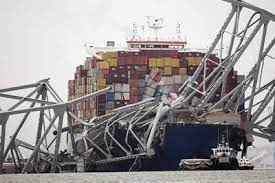
BALTIMORE — The cargo ship that lost power and crashed into a bridge in Baltimore underwent “routine engine maintenance” in port beforehand, the U.S. Coast Guard said Wednesday, as divers recovered the bodies of two of six workers who plunged into the water when it collapsed. The others were presumed dead, and officials said search efforts had been exhausted.
Investigators began collecting evidence from the vessel a day after it struck the Francis Scott Key Bridge. The bodies of the two men were located in the morning inside a red pickup submerged in about 25 feet (7.6 meters) of water near the bridge’s middle span, Col. Roland L. Butler Jr., superintendent of Maryland State Police, announced at an evening news conference.
He identified the men as Alejandro Hernandez Fuentes, 35, who was from Mexico and living in Baltimore, and Dorlian Ronial Castillo Cabrera, 26, who was from Guatemala and living in Dundalk, Maryland.
Maryland Gov. Wes Moore addressed their families in Spanish during the news conference, saying, “Estamos contigo, ahora y siempre,” which means, “we are with you, now and always.”
Cargo ship had engine maintenance in port before it collided with Baltimore bridge, officials say.
As the search for victims under a Baltimore bridge continues, survivors of previous bridge disasters shared their stories with the Associated Press.
All search efforts have been exhausted, and based on sonar scans, authorities “firmly” believe the other vehicles with victims are encased in material from the collapsed bridge, Butler said. Divers are to resume searching once the debris is cleared.
Coast Guard Rear Admiral Shannon Gilreath said at the news conference that authorities were informed that the ship was going to undergo the maintenance.
“As far as the engine goes, we were not informed of any problems with the vessel,” he said.
The Baltimore region has reeled from the sudden loss of a major transportation link that’s part of the highway loop around the city. The disaster also closed the port, which is vital to the city’s shipping industry.
National Transportation Safety Board officials boarded the ship to recover information from its electronics and paperwork and to interview the captain and other crew members, NTSB Chair Jennifer Homendy said during a separate news conference. Twenty-three people, including two pilots, were on the ship when it crashed, she said.
The vessel was also carrying 56 containers of hazardous materials including corrosives, flammables and lithium ion batteries, Homendy said. She added that some containers were breached, and that a sheen on the water from those materials would be handled by authorities.
Marcel Muise, NTSB investigator in charge, laid out a preliminary timeline assembled from the voyage data recorder comprising audio from the bridge and VHF radio ahead of the crash, which federal and state officials have said appeared to be an accident.
The vessel, the Dali, left port at 12:39 a.m. Tuesday and, after it entered the channel, signs of trouble came at about 1:25 a.m. when numerous alarms sounded, according to the NTSB. About a minute later, steering commands and rudder orders were issued, and at 1:26 a.m. and 39 seconds, a pilot made a general radio call for nearby tug boats.
Maryland Transportation Authority data from about the same time shows the pilot association dispatcher called the transportation authority’s officer on duty about the blackout, the NTSB said.
Just after 1:27 a.m., the pilot commanded the ship to drop an anchor on the left side of the ship and issued added steering commands. About 20 seconds later, the pilot issued a radio call reporting that the Dali had lost all power approaching the bridge.
At about that time, the state transportation officer on duty radioed two of its units already stationed at each end of the bridge saying to close the bridge to vehicle traffic. They were already there because of the construction.
Around 1:29 a.m., when the ship was traveling at about 8 mph (13 kph), recordings for about 30 seconds picked up sounds consistent with it colliding with the bridge, the NTSB said. A Transportation Authority dash camera also shows lights on the bridge going out.
Cargo ship had engine maintenance in port before it collided with Baltimore bridge, officials say.
Washington correspondent Sagar Meghani reports the Biden administration is looking at rebuilding and reopening in Baltimore — while warning of a long road ahead.At 1:29 a.m. and 39 seconds, the pilot reported to the Coast Guard that the bridge was down.
Muise said experts will review the entire voyage data recording and develop a detailed transcript.
At least eight people initially went into the water when the ship struck the bridge column, and two of them were rescued Tuesday, officials said.
Traffic was still crossing the span as the ship approached, and some vehicles appeared to escape with only seconds to spare. The crash caused the bridge to break and fall into the water within seconds.
Authorities had just enough time to stop vehicle traffic. One officer parked sideways across the lanes and planned to drive onto the bridge to alert the construction crew once another officer arrived, but he did not get a chance.
The debris complicated the search for the workers, according to a Homeland Security memo described to The Associated Press by a law enforcement official who was not authorized to discuss details of the document or the investigation and spoke on condition of anonymity.




